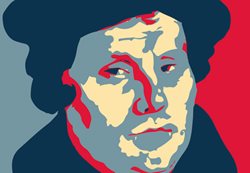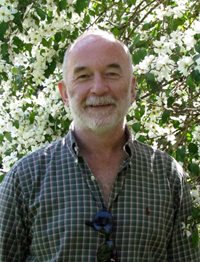On 31st October 1517 Martin Luther nailed his famous ‘95 theses’ to the door of the Castle Church in the German town of Wittenberg – an action that is popularly interpreted as the start of
the European Reformation.
His teachings instigated a period of unprecedented change and upheaval, altering the course of European history and setting in motion a chain of events, which still affect us today.
Early life
 Born in Saxony on 10th November 1483 to Hans and Margaret Luder (he changed his surname to Luther as a student), he was baptised on St. Martin’s Day hence his Christian name. Hans invested in his son’s education and Martin attended a number of schools before entering Erfurt University in 1501. By 1505 he had gained both a bachelors and masters degree, and was planning to get married and start a law career. A few weeks before his law course started, Luther was assailed by what he called anfectung – literally ‘an attack’, an anguished spiritual and emotional experience in which he felt crushed by a sense of personal guilt and sinfulness.
Born in Saxony on 10th November 1483 to Hans and Margaret Luder (he changed his surname to Luther as a student), he was baptised on St. Martin’s Day hence his Christian name. Hans invested in his son’s education and Martin attended a number of schools before entering Erfurt University in 1501. By 1505 he had gained both a bachelors and masters degree, and was planning to get married and start a law career. A few weeks before his law course started, Luther was assailed by what he called anfectung – literally ‘an attack’, an anguished spiritual and emotional experience in which he felt crushed by a sense of personal guilt and sinfulness.
Caught in a thunderstorm and almost struck by lightning when returning to university from home four weeks into starting his course, he promised God in that moment of private terror, that he would become a monk if his life was spared. Within two weeks, on 17th July 1505, Luther had abandoned his legal studies and entered the Augustinian priory at Erfurt.
On 4th April 1507, after completing his novitiate training he was ordained a priest. On 9th March 1509 he was awarded his theological degree. Throughout his studies he came to reject the contemporary fashion of splicing philosophy and theology, preferring to jettison philosophy and focus on the foundational Christian documents of the Old and New Testaments.
Luther’s career was advancing apace; seconded as a lecturer to the new University of Wittenberg and undertaking doctoral studies in theology, he was still susceptible to spates of anfectung.
Spiritual breakthrough
Martin Luther enjoyed his studies, becoming proficient in Hebrew and Greek in order to better interpret the
Old and New Testaments. He received
his doctorate on 18th October 1512 and was appointed to the professorial chair in Biblical Studies at Wittenberg University the following year. Still an Augustinian monk, he was sub-prior to the Wittenberg monastery but revelled in his new lecturing responsibilities.
His spiritual breakthrough cannot be precisely dated, but certainly occurred sometime between 1513 and 1517. Luther gained a fresh understanding of how God can forgive a sinner. Previously terrified by his concept of an angry and righteous God and his own sinfulness, he now realised that personal salvation is a gift which God gives us; Christ’s righteousness is given to us when we have faith in Him: “The righteous shall live by faith” (Romans 1:17).
Increasingly in his lectures Luther moved away from philosophy and became absorbed in the challenge of understanding and explaining Scripture. His method was to explain the biblical text in its original context and then apply the text to the contemporary situation. This novel teaching style became known as the ‘new learning’ and gained a meteoric reputation for Martin Luther.
Additionally, he was preaching regularly in both local churches where he also shared his new insights from the pulpit. The importance of Luther’s personal experience, which he then poured into his teaching and preaching cannot be overemphasised.
The 95 theses
A date that is probably one of the most significant in modern history – Wednesday, 31st October 1517 saw Luther nail his 95 theses to the door of the Castle Church in Wittenberg.
What he had intended to be a list of short theological statements, to be debated within the university, was to change the course of world history. We will take a look at the break with Rome and Luther’s legacy in Part Two.
 Laurence Kirkpatrick is Professor of Church History at Union Theological College. He studied Ancient History, Semitic Studies and Theology (UTC)at Queen's University (QUB) and Early Church History at the University of Glasgow. He was minister of Muckamore Presbyterian Church for 12 years before his appointment UTC in 1996. Professor Kirkpatrick is also He chair of the Systematic Theology, Practical Theology, and Church History Subject Board of the Queen’s University Institute of Theology.
Laurence Kirkpatrick is Professor of Church History at Union Theological College. He studied Ancient History, Semitic Studies and Theology (UTC)at Queen's University (QUB) and Early Church History at the University of Glasgow. He was minister of Muckamore Presbyterian Church for 12 years before his appointment UTC in 1996. Professor Kirkpatrick is also He chair of the Systematic Theology, Practical Theology, and Church History Subject Board of the Queen’s University Institute of Theology.
This blog is based on an article that first appeared in the December 2016 edition of the Presbyterian Herald. You can read part 2 here.
Faith at the Crossroads: This special celebration of the 500th anniversary of the Reformation will take place on 17th/18th/19th October in Dublin/Londonderry/Belfast respectively. For more details visit our events page.